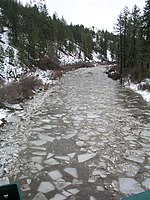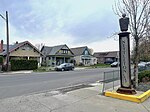Fort George Wright
1896 establishments in Washington (state)Buildings and structures in Spokane, WashingtonColonial Revival architecture in Washington (state)Forts in Washington (state)Forts on the National Register of Historic Places in Washington (state) ... and 4 more
Historic districts on the National Register of Historic Places in Washington (state)NRHP infobox with nocatNational Register of Historic Places in Spokane, WashingtonQueen Anne architecture in Washington (state)

Fort George Wright is a land area in the northwest United States, located in Spokane, Washington's West Hills neighborhood. It is named after General George Wright, who had been stationed in the area.
Excerpt from the Wikipedia article Fort George Wright (License: CC BY-SA 3.0, Authors, Images).Fort George Wright
North Wright Road, Spokane
Geographical coordinates (GPS) Address Nearby Places Show on map
Geographical coordinates (GPS)
| Latitude | Longitude |
|---|---|
| N 47.678333333333 ° | E -117.47416666667 ° |
Address
Mukogawa Ft. Wright Institute
North Wright Road
99201 Spokane
Washington, United States
Open on Google Maps








